Unit 16: Operations and Project Management Assignment Report
VerifiedAdded on 2023/01/11
|21
|6108
|39
Report
AI Summary
This report provides a comprehensive analysis of operations and project management principles, focusing on continuous improvement and project life cycle methodologies. It explores the objectives and principles of operations management, examining various approaches and strategies. The report delves into the concept of continuous improvement, presenting a continuous improvement plan and analyzing its effectiveness, particularly within the context of Toyota Motor Manufacturing UK. It evaluates the implementation of Six-Sigma and Lean principles, alongside strategies for achieving continuous improvement and efficiency. Furthermore, the report applies the project life cycle (PLC), analyzing the use of Work Breakdown Structure (WBS), Gantt Charts, and Critical Path methods, and critiquing their effectiveness in both large and small-scale projects. The study incorporates practical and theoretical aspects of PLC, offering insights into achieving continuous improvement and project success.

Operations and Project
Management
Management
Paraphrase This Document
Need a fresh take? Get an instant paraphrase of this document with our AI Paraphraser
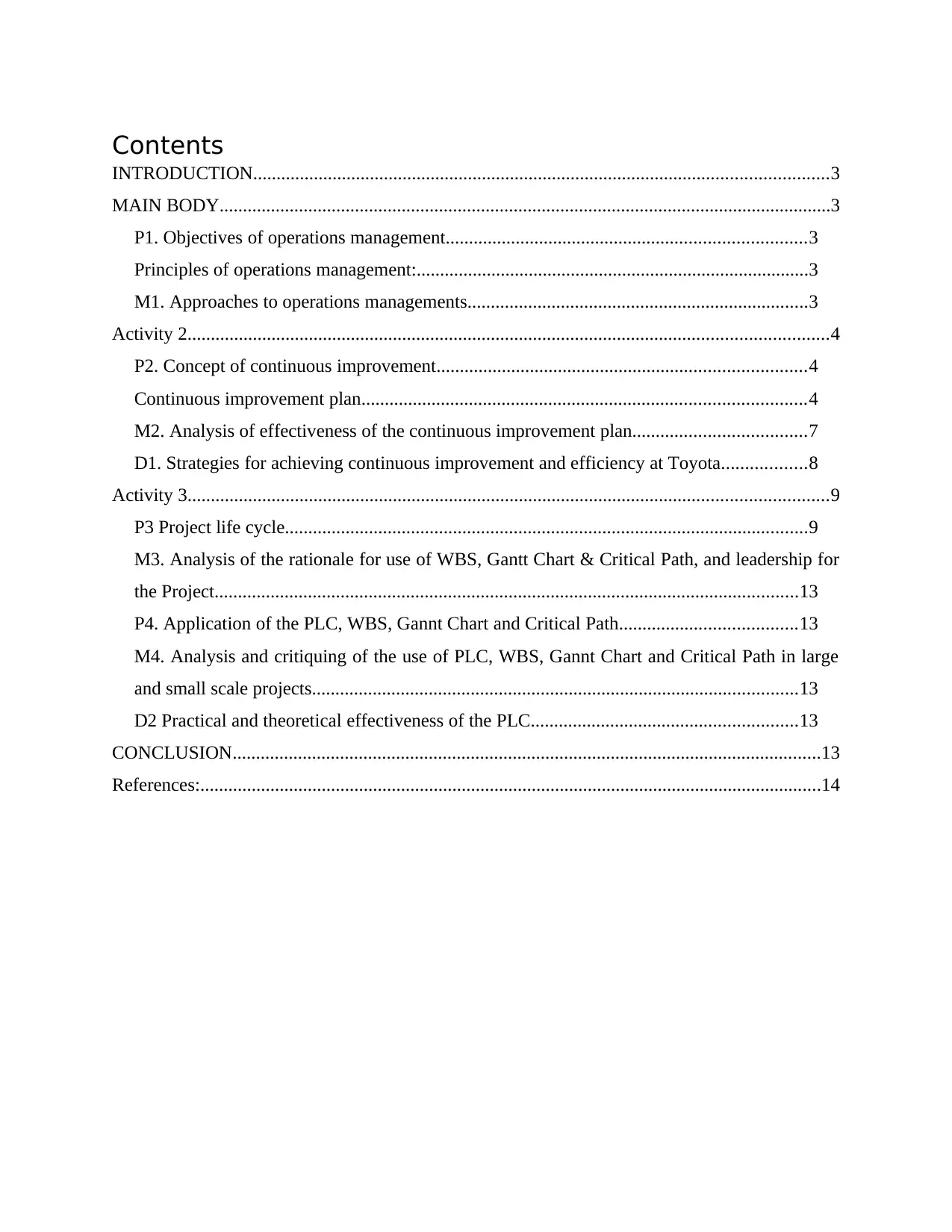
Contents
INTRODUCTION...........................................................................................................................3
MAIN BODY...................................................................................................................................3
P1. Objectives of operations management.............................................................................3
Principles of operations management:....................................................................................3
M1. Approaches to operations managements.........................................................................3
Activity 2.........................................................................................................................................4
P2. Concept of continuous improvement...............................................................................4
Continuous improvement plan...............................................................................................4
M2. Analysis of effectiveness of the continuous improvement plan.....................................7
D1. Strategies for achieving continuous improvement and efficiency at Toyota..................8
Activity 3.........................................................................................................................................9
P3 Project life cycle................................................................................................................9
M3. Analysis of the rationale for use of WBS, Gantt Chart & Critical Path, and leadership for
the Project.............................................................................................................................13
P4. Application of the PLC, WBS, Gannt Chart and Critical Path......................................13
M4. Analysis and critiquing of the use of PLC, WBS, Gannt Chart and Critical Path in large
and small scale projects........................................................................................................13
D2 Practical and theoretical effectiveness of the PLC.........................................................13
CONCLUSION..............................................................................................................................13
References:.....................................................................................................................................14
INTRODUCTION...........................................................................................................................3
MAIN BODY...................................................................................................................................3
P1. Objectives of operations management.............................................................................3
Principles of operations management:....................................................................................3
M1. Approaches to operations managements.........................................................................3
Activity 2.........................................................................................................................................4
P2. Concept of continuous improvement...............................................................................4
Continuous improvement plan...............................................................................................4
M2. Analysis of effectiveness of the continuous improvement plan.....................................7
D1. Strategies for achieving continuous improvement and efficiency at Toyota..................8
Activity 3.........................................................................................................................................9
P3 Project life cycle................................................................................................................9
M3. Analysis of the rationale for use of WBS, Gantt Chart & Critical Path, and leadership for
the Project.............................................................................................................................13
P4. Application of the PLC, WBS, Gannt Chart and Critical Path......................................13
M4. Analysis and critiquing of the use of PLC, WBS, Gannt Chart and Critical Path in large
and small scale projects........................................................................................................13
D2 Practical and theoretical effectiveness of the PLC.........................................................13
CONCLUSION..............................................................................................................................13
References:.....................................................................................................................................14
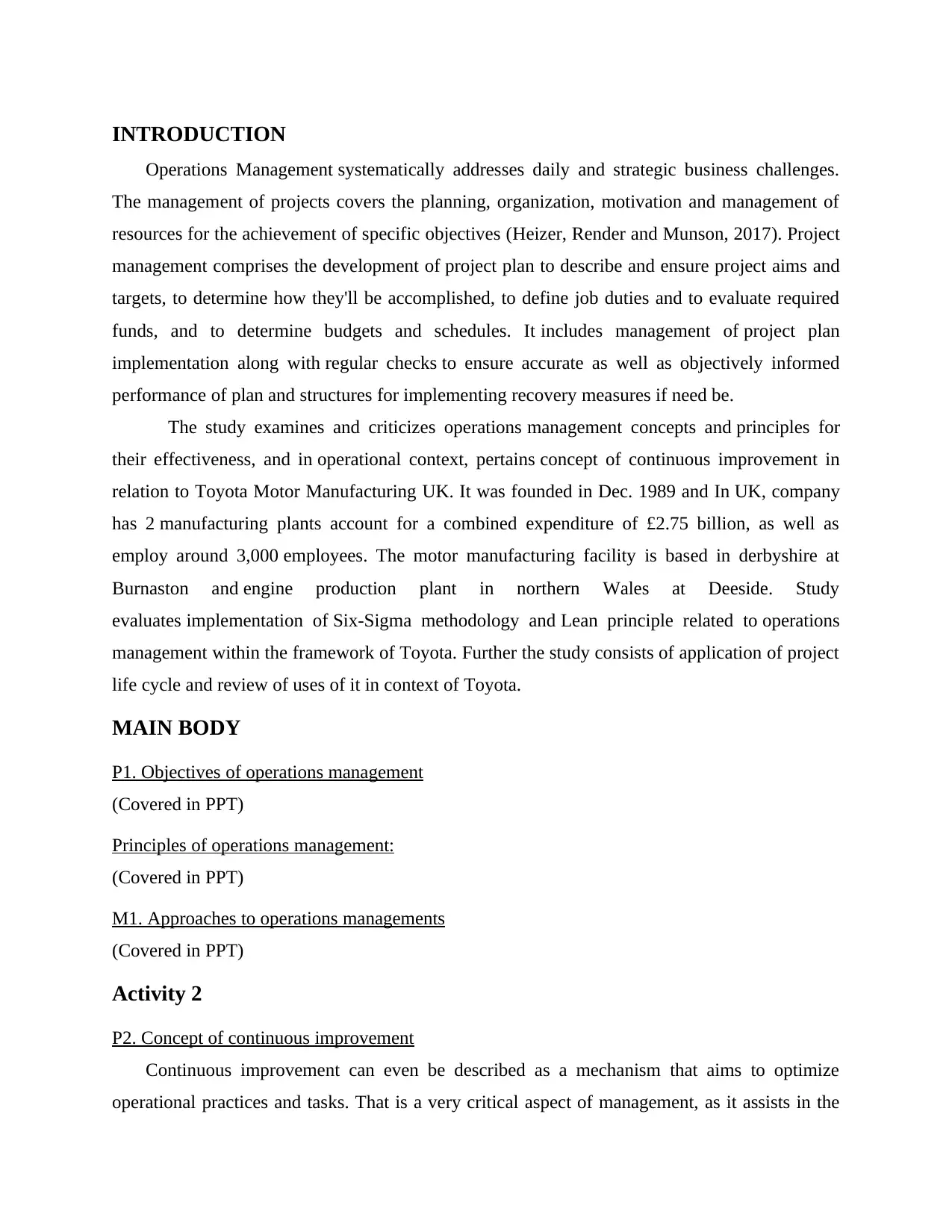
INTRODUCTION
Operations Management systematically addresses daily and strategic business challenges.
The management of projects covers the planning, organization, motivation and management of
resources for the achievement of specific objectives (Heizer, Render and Munson, 2017). Project
management comprises the development of project plan to describe and ensure project aims and
targets, to determine how they'll be accomplished, to define job duties and to evaluate required
funds, and to determine budgets and schedules. It includes management of project plan
implementation along with regular checks to ensure accurate as well as objectively informed
performance of plan and structures for implementing recovery measures if need be.
The study examines and criticizes operations management concepts and principles for
their effectiveness, and in operational context, pertains concept of continuous improvement in
relation to Toyota Motor Manufacturing UK. It was founded in Dec. 1989 and In UK, company
has 2 manufacturing plants account for a combined expenditure of £2.75 billion, as well as
employ around 3,000 employees. The motor manufacturing facility is based in derbyshire at
Burnaston and engine production plant in northern Wales at Deeside. Study
evaluates implementation of Six-Sigma methodology and Lean principle related to operations
management within the framework of Toyota. Further the study consists of application of project
life cycle and review of uses of it in context of Toyota.
MAIN BODY
P1. Objectives of operations management
(Covered in PPT)
Principles of operations management:
(Covered in PPT)
M1. Approaches to operations managements
(Covered in PPT)
Activity 2
P2. Concept of continuous improvement
Continuous improvement can even be described as a mechanism that aims to optimize
operational practices and tasks. That is a very critical aspect of management, as it assists in the
Operations Management systematically addresses daily and strategic business challenges.
The management of projects covers the planning, organization, motivation and management of
resources for the achievement of specific objectives (Heizer, Render and Munson, 2017). Project
management comprises the development of project plan to describe and ensure project aims and
targets, to determine how they'll be accomplished, to define job duties and to evaluate required
funds, and to determine budgets and schedules. It includes management of project plan
implementation along with regular checks to ensure accurate as well as objectively informed
performance of plan and structures for implementing recovery measures if need be.
The study examines and criticizes operations management concepts and principles for
their effectiveness, and in operational context, pertains concept of continuous improvement in
relation to Toyota Motor Manufacturing UK. It was founded in Dec. 1989 and In UK, company
has 2 manufacturing plants account for a combined expenditure of £2.75 billion, as well as
employ around 3,000 employees. The motor manufacturing facility is based in derbyshire at
Burnaston and engine production plant in northern Wales at Deeside. Study
evaluates implementation of Six-Sigma methodology and Lean principle related to operations
management within the framework of Toyota. Further the study consists of application of project
life cycle and review of uses of it in context of Toyota.
MAIN BODY
P1. Objectives of operations management
(Covered in PPT)
Principles of operations management:
(Covered in PPT)
M1. Approaches to operations managements
(Covered in PPT)
Activity 2
P2. Concept of continuous improvement
Continuous improvement can even be described as a mechanism that aims to optimize
operational practices and tasks. That is a very critical aspect of management, as it assists in the
⊘ This is a preview!⊘
Do you want full access?
Subscribe today to unlock all pages.

Trusted by 1+ million students worldwide
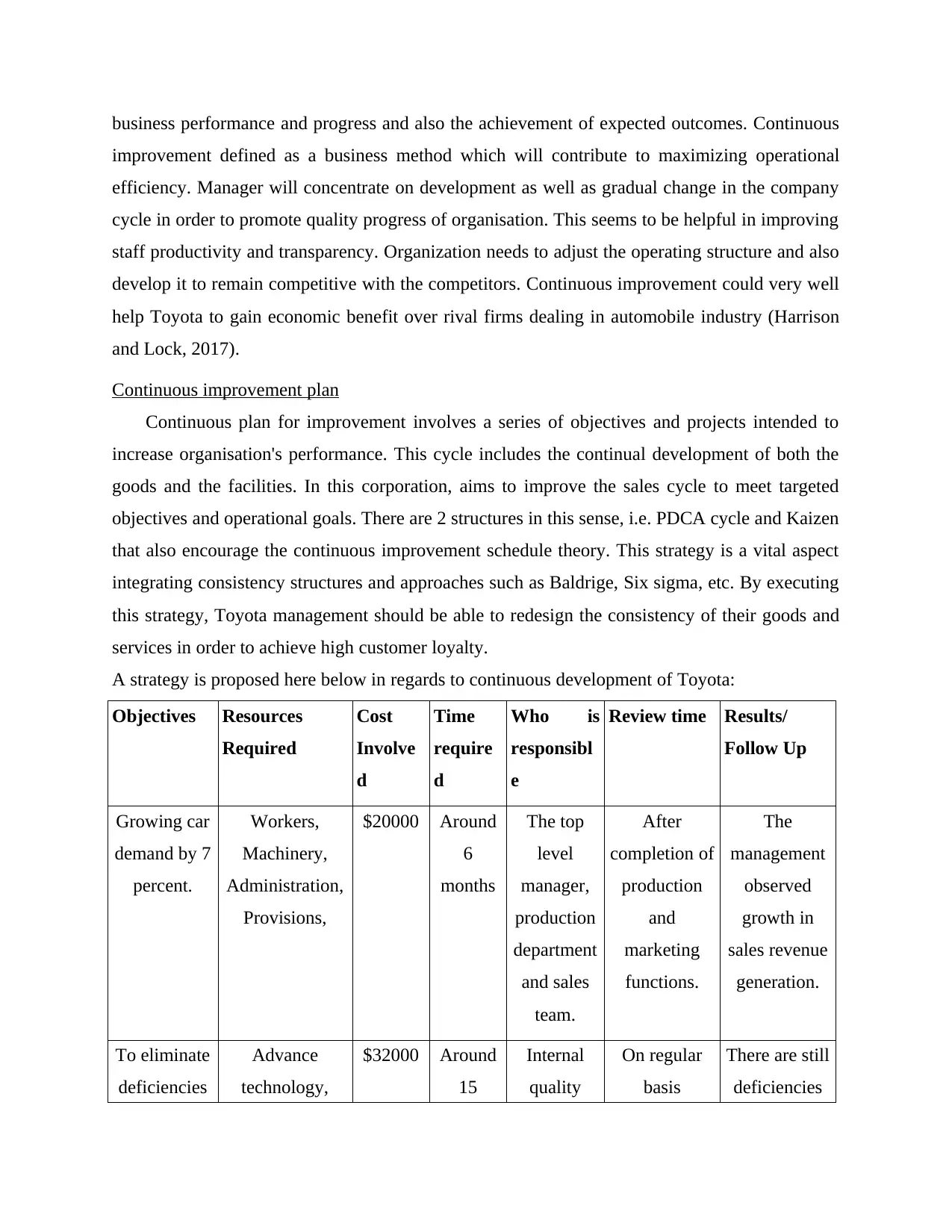
business performance and progress and also the achievement of expected outcomes. Continuous
improvement defined as a business method which will contribute to maximizing operational
efficiency. Manager will concentrate on development as well as gradual change in the company
cycle in order to promote quality progress of organisation. This seems to be helpful in improving
staff productivity and transparency. Organization needs to adjust the operating structure and also
develop it to remain competitive with the competitors. Continuous improvement could very well
help Toyota to gain economic benefit over rival firms dealing in automobile industry (Harrison
and Lock, 2017).
Continuous improvement plan
Continuous plan for improvement involves a series of objectives and projects intended to
increase organisation's performance. This cycle includes the continual development of both the
goods and the facilities. In this corporation, aims to improve the sales cycle to meet targeted
objectives and operational goals. There are 2 structures in this sense, i.e. PDCA cycle and Kaizen
that also encourage the continuous improvement schedule theory. This strategy is a vital aspect
integrating consistency structures and approaches such as Baldrige, Six sigma, etc. By executing
this strategy, Toyota management should be able to redesign the consistency of their goods and
services in order to achieve high customer loyalty.
A strategy is proposed here below in regards to continuous development of Toyota:
Objectives Resources
Required
Cost
Involve
d
Time
require
d
Who is
responsibl
e
Review time Results/
Follow Up
Growing car
demand by 7
percent.
Workers,
Machinery,
Administration,
Provisions,
$20000 Around
6
months
The top
level
manager,
production
department
and sales
team.
After
completion of
production
and
marketing
functions.
The
management
observed
growth in
sales revenue
generation.
To eliminate
deficiencies
Advance
technology,
$32000 Around
15
Internal
quality
On regular
basis
There are still
deficiencies
improvement defined as a business method which will contribute to maximizing operational
efficiency. Manager will concentrate on development as well as gradual change in the company
cycle in order to promote quality progress of organisation. This seems to be helpful in improving
staff productivity and transparency. Organization needs to adjust the operating structure and also
develop it to remain competitive with the competitors. Continuous improvement could very well
help Toyota to gain economic benefit over rival firms dealing in automobile industry (Harrison
and Lock, 2017).
Continuous improvement plan
Continuous plan for improvement involves a series of objectives and projects intended to
increase organisation's performance. This cycle includes the continual development of both the
goods and the facilities. In this corporation, aims to improve the sales cycle to meet targeted
objectives and operational goals. There are 2 structures in this sense, i.e. PDCA cycle and Kaizen
that also encourage the continuous improvement schedule theory. This strategy is a vital aspect
integrating consistency structures and approaches such as Baldrige, Six sigma, etc. By executing
this strategy, Toyota management should be able to redesign the consistency of their goods and
services in order to achieve high customer loyalty.
A strategy is proposed here below in regards to continuous development of Toyota:
Objectives Resources
Required
Cost
Involve
d
Time
require
d
Who is
responsibl
e
Review time Results/
Follow Up
Growing car
demand by 7
percent.
Workers,
Machinery,
Administration,
Provisions,
$20000 Around
6
months
The top
level
manager,
production
department
and sales
team.
After
completion of
production
and
marketing
functions.
The
management
observed
growth in
sales revenue
generation.
To eliminate
deficiencies
Advance
technology,
$32000 Around
15
Internal
quality
On regular
basis
There are still
deficiencies
Paraphrase This Document
Need a fresh take? Get an instant paraphrase of this document with our AI Paraphraser
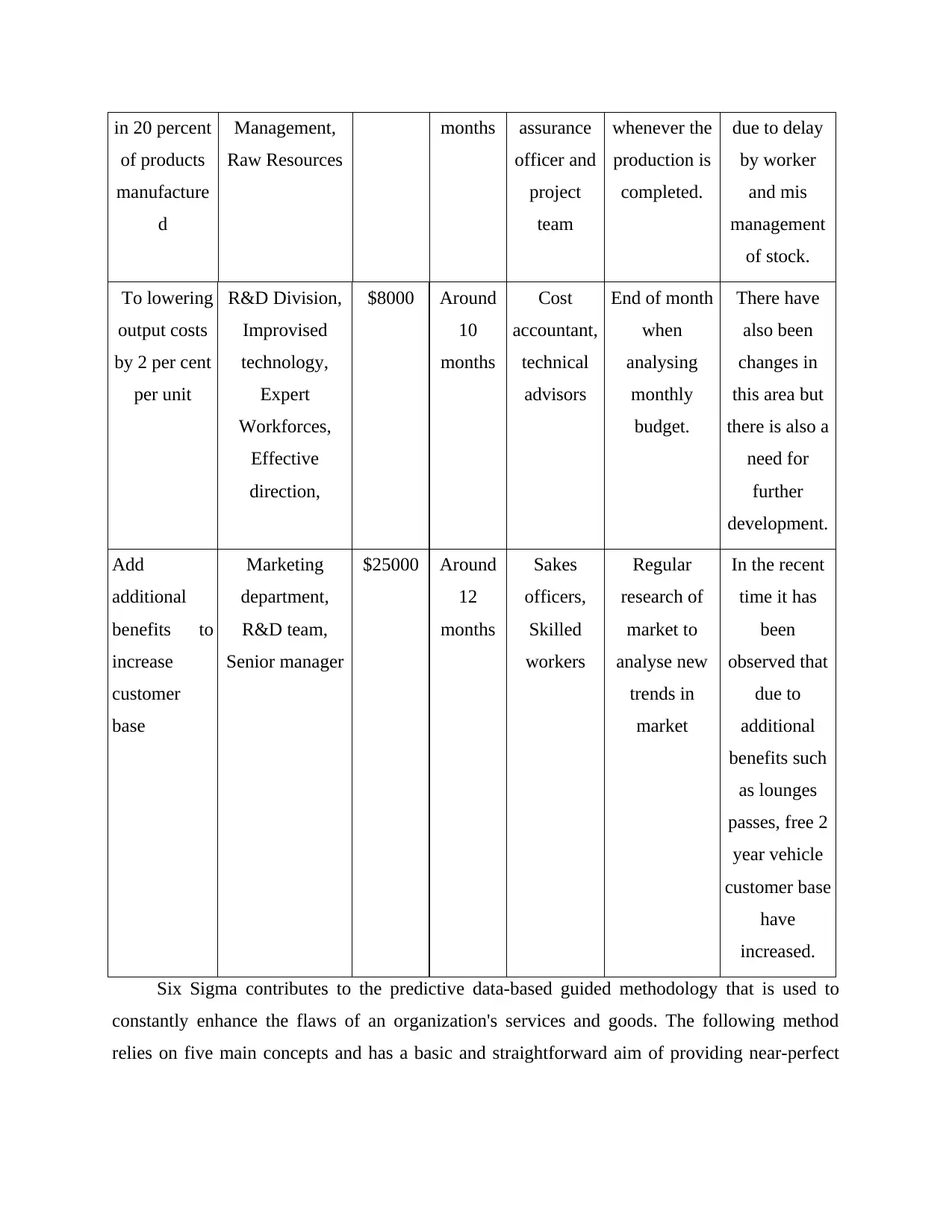
in 20 percent
of products
manufacture
d
Management,
Raw Resources
months assurance
officer and
project
team
whenever the
production is
completed.
due to delay
by worker
and mis
management
of stock.
To lowering
output costs
by 2 per cent
per unit
R&D Division,
Improvised
technology,
Expert
Workforces,
Effective
direction,
$8000 Around
10
months
Cost
accountant,
technical
advisors
End of month
when
analysing
monthly
budget.
There have
also been
changes in
this area but
there is also a
need for
further
development.
Add
additional
benefits to
increase
customer
base
Marketing
department,
R&D team,
Senior manager
$25000 Around
12
months
Sakes
officers,
Skilled
workers
Regular
research of
market to
analyse new
trends in
market
In the recent
time it has
been
observed that
due to
additional
benefits such
as lounges
passes, free 2
year vehicle
customer base
have
increased.
Six Sigma contributes to the predictive data-based guided methodology that is used to
constantly enhance the flaws of an organization's services and goods. The following method
relies on five main concepts and has a basic and straightforward aim of providing near-perfect
of products
manufacture
d
Management,
Raw Resources
months assurance
officer and
project
team
whenever the
production is
completed.
due to delay
by worker
and mis
management
of stock.
To lowering
output costs
by 2 per cent
per unit
R&D Division,
Improvised
technology,
Expert
Workforces,
Effective
direction,
$8000 Around
10
months
Cost
accountant,
technical
advisors
End of month
when
analysing
monthly
budget.
There have
also been
changes in
this area but
there is also a
need for
further
development.
Add
additional
benefits to
increase
customer
base
Marketing
department,
R&D team,
Senior manager
$25000 Around
12
months
Sakes
officers,
Skilled
workers
Regular
research of
market to
analyse new
trends in
market
In the recent
time it has
been
observed that
due to
additional
benefits such
as lounges
passes, free 2
year vehicle
customer base
have
increased.
Six Sigma contributes to the predictive data-based guided methodology that is used to
constantly enhance the flaws of an organization's services and goods. The following method
relies on five main concepts and has a basic and straightforward aim of providing near-perfect
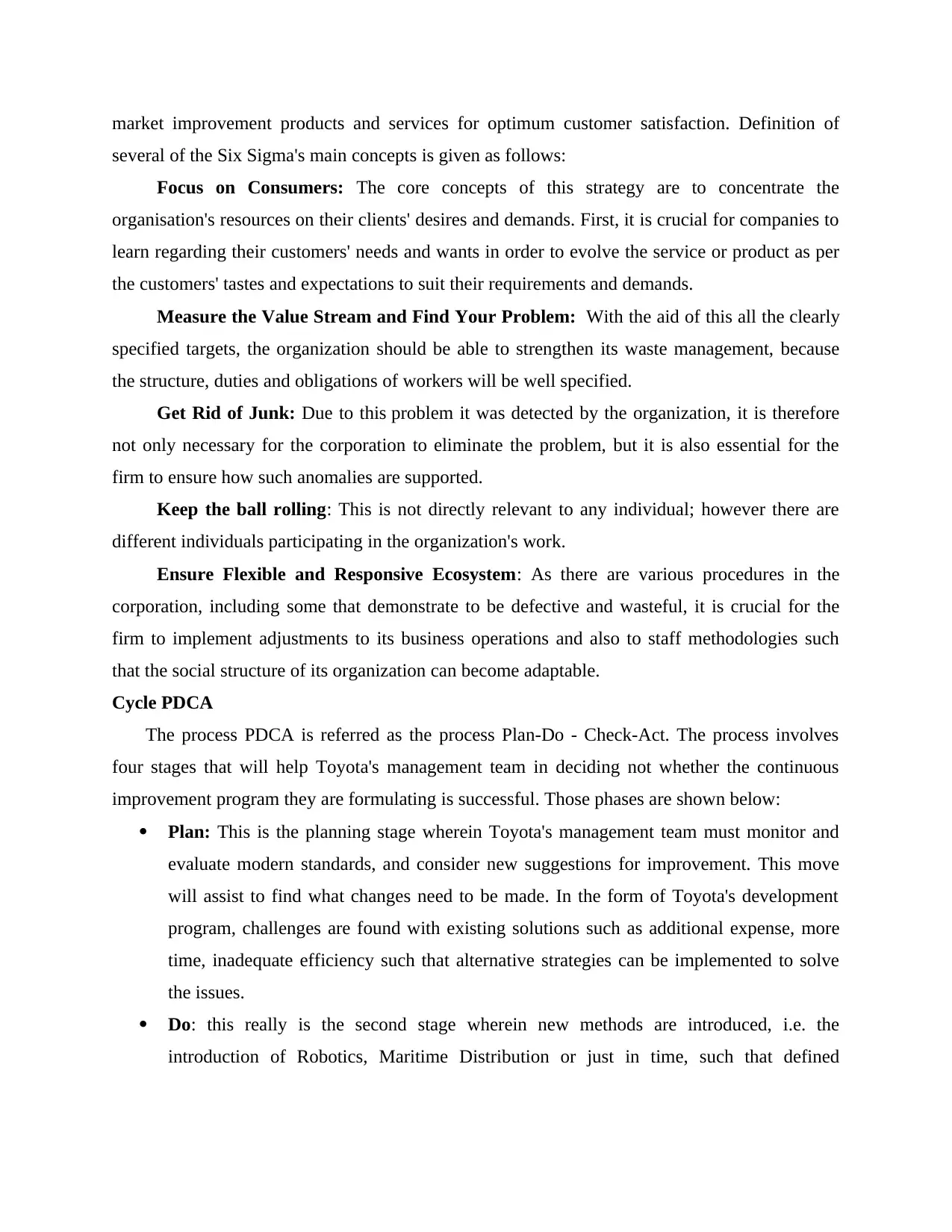
market improvement products and services for optimum customer satisfaction. Definition of
several of the Six Sigma's main concepts is given as follows:
Focus on Consumers: The core concepts of this strategy are to concentrate the
organisation's resources on their clients' desires and demands. First, it is crucial for companies to
learn regarding their customers' needs and wants in order to evolve the service or product as per
the customers' tastes and expectations to suit their requirements and demands.
Measure the Value Stream and Find Your Problem: With the aid of this all the clearly
specified targets, the organization should be able to strengthen its waste management, because
the structure, duties and obligations of workers will be well specified.
Get Rid of Junk: Due to this problem it was detected by the organization, it is therefore
not only necessary for the corporation to eliminate the problem, but it is also essential for the
firm to ensure how such anomalies are supported.
Keep the ball rolling: This is not directly relevant to any individual; however there are
different individuals participating in the organization's work.
Ensure Flexible and Responsive Ecosystem: As there are various procedures in the
corporation, including some that demonstrate to be defective and wasteful, it is crucial for the
firm to implement adjustments to its business operations and also to staff methodologies such
that the social structure of its organization can become adaptable.
Cycle PDCA
The process PDCA is referred as the process Plan-Do - Check-Act. The process involves
four stages that will help Toyota's management team in deciding not whether the continuous
improvement program they are formulating is successful. Those phases are shown below:
Plan: This is the planning stage wherein Toyota's management team must monitor and
evaluate modern standards, and consider new suggestions for improvement. This move
will assist to find what changes need to be made. In the form of Toyota's development
program, challenges are found with existing solutions such as additional expense, more
time, inadequate efficiency such that alternative strategies can be implemented to solve
the issues.
Do: this really is the second stage wherein new methods are introduced, i.e. the
introduction of Robotics, Maritime Distribution or just in time, such that defined
several of the Six Sigma's main concepts is given as follows:
Focus on Consumers: The core concepts of this strategy are to concentrate the
organisation's resources on their clients' desires and demands. First, it is crucial for companies to
learn regarding their customers' needs and wants in order to evolve the service or product as per
the customers' tastes and expectations to suit their requirements and demands.
Measure the Value Stream and Find Your Problem: With the aid of this all the clearly
specified targets, the organization should be able to strengthen its waste management, because
the structure, duties and obligations of workers will be well specified.
Get Rid of Junk: Due to this problem it was detected by the organization, it is therefore
not only necessary for the corporation to eliminate the problem, but it is also essential for the
firm to ensure how such anomalies are supported.
Keep the ball rolling: This is not directly relevant to any individual; however there are
different individuals participating in the organization's work.
Ensure Flexible and Responsive Ecosystem: As there are various procedures in the
corporation, including some that demonstrate to be defective and wasteful, it is crucial for the
firm to implement adjustments to its business operations and also to staff methodologies such
that the social structure of its organization can become adaptable.
Cycle PDCA
The process PDCA is referred as the process Plan-Do - Check-Act. The process involves
four stages that will help Toyota's management team in deciding not whether the continuous
improvement program they are formulating is successful. Those phases are shown below:
Plan: This is the planning stage wherein Toyota's management team must monitor and
evaluate modern standards, and consider new suggestions for improvement. This move
will assist to find what changes need to be made. In the form of Toyota's development
program, challenges are found with existing solutions such as additional expense, more
time, inadequate efficiency such that alternative strategies can be implemented to solve
the issues.
Do: this really is the second stage wherein new methods are introduced, i.e. the
introduction of Robotics, Maritime Distribution or just in time, such that defined
⊘ This is a preview!⊘
Do you want full access?
Subscribe today to unlock all pages.

Trusted by 1+ million students worldwide

problems can be addressed without infringing on operational efficiency (Maylo and
Turner, 2017).
Check: At this point, Toyota Plc manager must calculate the improvements that can be
made by combining existing methods and techniques with the methodologies suggested.
As per the current context, all the previously problems encountered by Toyota are
addressed in a proper way by the application of suggested techniques.
Act: This step will determine whether or not the improvements introduced are to be fully
followed. In Toyota's situation, the corporation should make those improvements because
they profit from addressing all the problems that diminished the brand’s profitability.
M2. Analysis of effectiveness of the continuous improvement plan
Mostly with assistance of multiple modelling techniques, technologies, ideas, or principles,
it was greatly enhanced to meet the targets of the strategy for development properly. There are
numerous ideas and methods that are used in an organization's work that achieving quality the
organization's overall performance (Binder, 2016). The strategy should be redesigned
concurrently with this in order to meet goals that have not been completely accomplished. This
time, the emphasis would be on certain fields where the differences have previously occurred so
this moment the discrepancies will not be detected because they've been excluded from the
organization's working methodologies (Sterman, Oliva Linderman and Bendoly, 2015). Both of
these strategies concentrate on making progress in the organization’s overall results.
All has been done with the goals. They aren't entirely done, however. There were some
anomalies owing to which the efficiency of the company wasn't really up to the mark of the
business applications. But with the aid of these methods, models, and principles, information
about the regions of divergence has been accomplished. Therefore, by learning about these fields
of anomalies, it could be important to enhance overall efficiency, such as implementing practices
and regulations with the aid of which the problems could be avoided. This will not result in any
significant changes in the organization's working procedures or in the needs and interests of
consumers, although it is essential for the organization to sustain on the market for some time.
But for the businesses, the consistency factor is most essential in order to maintain their
partnership with the workers successful for a long period of time. In fact, the association's
comparative edge over its rivals would still be possible.
Turner, 2017).
Check: At this point, Toyota Plc manager must calculate the improvements that can be
made by combining existing methods and techniques with the methodologies suggested.
As per the current context, all the previously problems encountered by Toyota are
addressed in a proper way by the application of suggested techniques.
Act: This step will determine whether or not the improvements introduced are to be fully
followed. In Toyota's situation, the corporation should make those improvements because
they profit from addressing all the problems that diminished the brand’s profitability.
M2. Analysis of effectiveness of the continuous improvement plan
Mostly with assistance of multiple modelling techniques, technologies, ideas, or principles,
it was greatly enhanced to meet the targets of the strategy for development properly. There are
numerous ideas and methods that are used in an organization's work that achieving quality the
organization's overall performance (Binder, 2016). The strategy should be redesigned
concurrently with this in order to meet goals that have not been completely accomplished. This
time, the emphasis would be on certain fields where the differences have previously occurred so
this moment the discrepancies will not be detected because they've been excluded from the
organization's working methodologies (Sterman, Oliva Linderman and Bendoly, 2015). Both of
these strategies concentrate on making progress in the organization’s overall results.
All has been done with the goals. They aren't entirely done, however. There were some
anomalies owing to which the efficiency of the company wasn't really up to the mark of the
business applications. But with the aid of these methods, models, and principles, information
about the regions of divergence has been accomplished. Therefore, by learning about these fields
of anomalies, it could be important to enhance overall efficiency, such as implementing practices
and regulations with the aid of which the problems could be avoided. This will not result in any
significant changes in the organization's working procedures or in the needs and interests of
consumers, although it is essential for the organization to sustain on the market for some time.
But for the businesses, the consistency factor is most essential in order to maintain their
partnership with the workers successful for a long period of time. In fact, the association's
comparative edge over its rivals would still be possible.
Paraphrase This Document
Need a fresh take? Get an instant paraphrase of this document with our AI Paraphraser
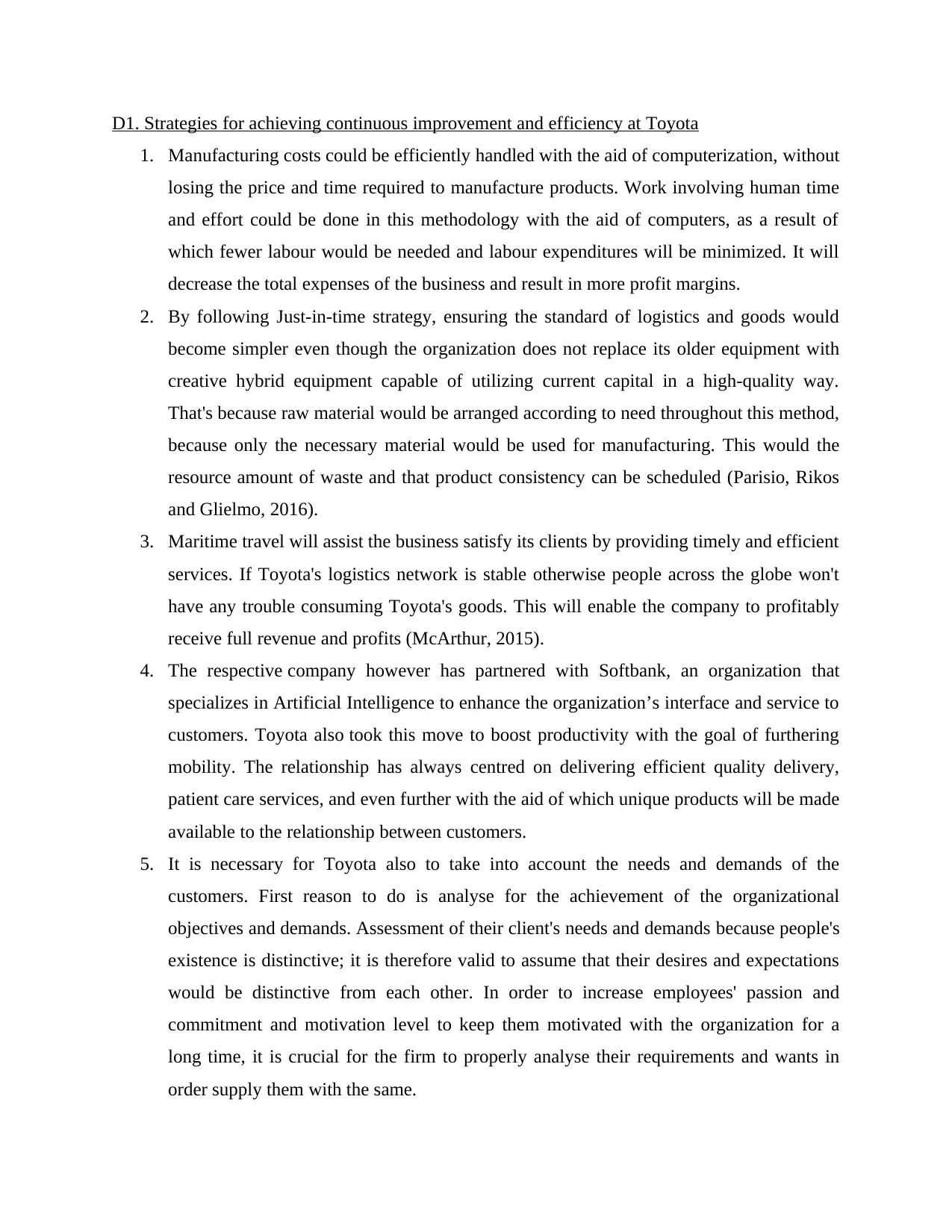
D1. Strategies for achieving continuous improvement and efficiency at Toyota
1. Manufacturing costs could be efficiently handled with the aid of computerization, without
losing the price and time required to manufacture products. Work involving human time
and effort could be done in this methodology with the aid of computers, as a result of
which fewer labour would be needed and labour expenditures will be minimized. It will
decrease the total expenses of the business and result in more profit margins.
2. By following Just-in-time strategy, ensuring the standard of logistics and goods would
become simpler even though the organization does not replace its older equipment with
creative hybrid equipment capable of utilizing current capital in a high-quality way.
That's because raw material would be arranged according to need throughout this method,
because only the necessary material would be used for manufacturing. This would the
resource amount of waste and that product consistency can be scheduled (Parisio, Rikos
and Glielmo, 2016).
3. Maritime travel will assist the business satisfy its clients by providing timely and efficient
services. If Toyota's logistics network is stable otherwise people across the globe won't
have any trouble consuming Toyota's goods. This will enable the company to profitably
receive full revenue and profits (McArthur, 2015).
4. The respective company however has partnered with Softbank, an organization that
specializes in Artificial Intelligence to enhance the organization’s interface and service to
customers. Toyota also took this move to boost productivity with the goal of furthering
mobility. The relationship has always centred on delivering efficient quality delivery,
patient care services, and even further with the aid of which unique products will be made
available to the relationship between customers.
5. It is necessary for Toyota also to take into account the needs and demands of the
customers. First reason to do is analyse for the achievement of the organizational
objectives and demands. Assessment of their client's needs and demands because people's
existence is distinctive; it is therefore valid to assume that their desires and expectations
would be distinctive from each other. In order to increase employees' passion and
commitment and motivation level to keep them motivated with the organization for a
long time, it is crucial for the firm to properly analyse their requirements and wants in
order supply them with the same.
1. Manufacturing costs could be efficiently handled with the aid of computerization, without
losing the price and time required to manufacture products. Work involving human time
and effort could be done in this methodology with the aid of computers, as a result of
which fewer labour would be needed and labour expenditures will be minimized. It will
decrease the total expenses of the business and result in more profit margins.
2. By following Just-in-time strategy, ensuring the standard of logistics and goods would
become simpler even though the organization does not replace its older equipment with
creative hybrid equipment capable of utilizing current capital in a high-quality way.
That's because raw material would be arranged according to need throughout this method,
because only the necessary material would be used for manufacturing. This would the
resource amount of waste and that product consistency can be scheduled (Parisio, Rikos
and Glielmo, 2016).
3. Maritime travel will assist the business satisfy its clients by providing timely and efficient
services. If Toyota's logistics network is stable otherwise people across the globe won't
have any trouble consuming Toyota's goods. This will enable the company to profitably
receive full revenue and profits (McArthur, 2015).
4. The respective company however has partnered with Softbank, an organization that
specializes in Artificial Intelligence to enhance the organization’s interface and service to
customers. Toyota also took this move to boost productivity with the goal of furthering
mobility. The relationship has always centred on delivering efficient quality delivery,
patient care services, and even further with the aid of which unique products will be made
available to the relationship between customers.
5. It is necessary for Toyota also to take into account the needs and demands of the
customers. First reason to do is analyse for the achievement of the organizational
objectives and demands. Assessment of their client's needs and demands because people's
existence is distinctive; it is therefore valid to assume that their desires and expectations
would be distinctive from each other. In order to increase employees' passion and
commitment and motivation level to keep them motivated with the organization for a
long time, it is crucial for the firm to properly analyse their requirements and wants in
order supply them with the same.
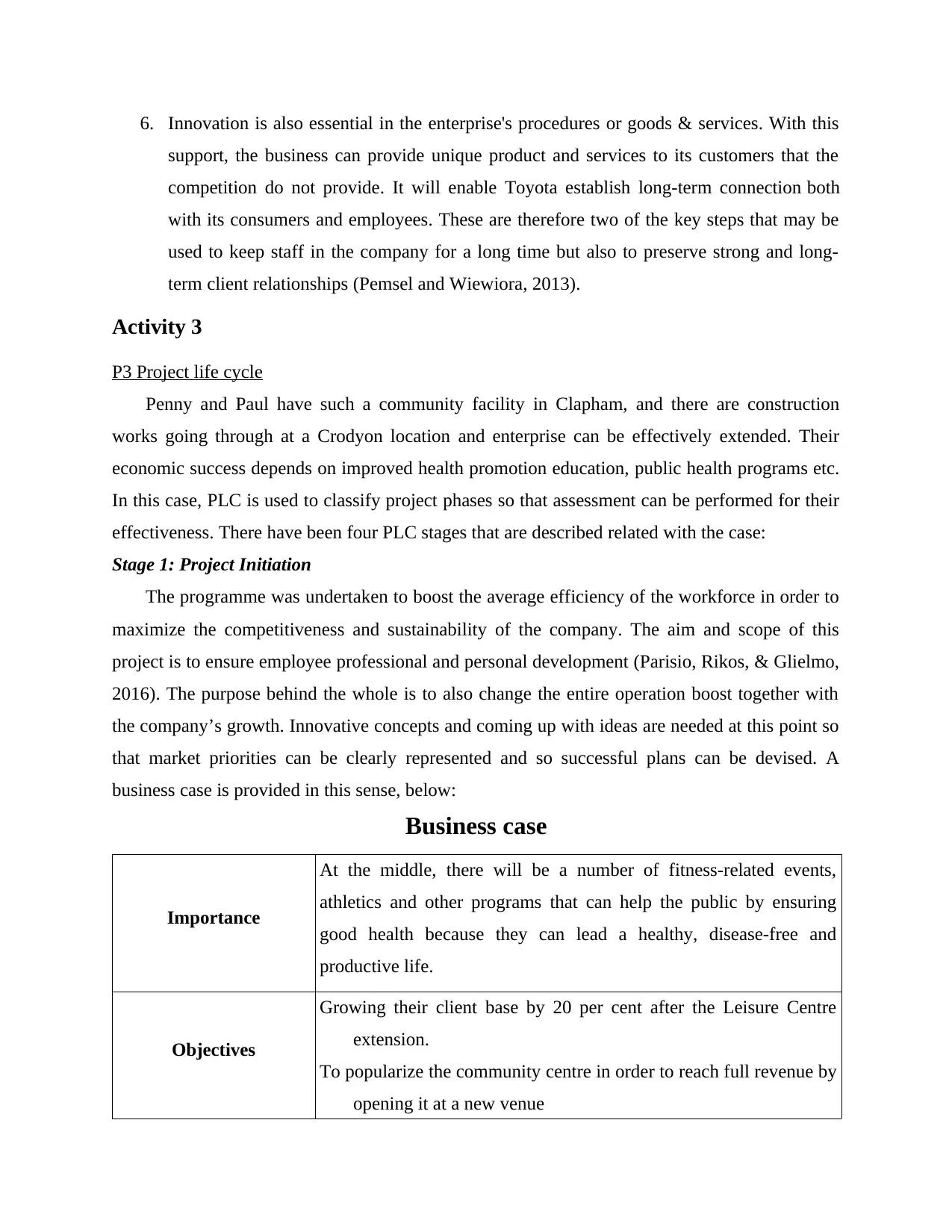
6. Innovation is also essential in the enterprise's procedures or goods & services. With this
support, the business can provide unique product and services to its customers that the
competition do not provide. It will enable Toyota establish long-term connection both
with its consumers and employees. These are therefore two of the key steps that may be
used to keep staff in the company for a long time but also to preserve strong and long-
term client relationships (Pemsel and Wiewiora, 2013).
Activity 3
P3 Project life cycle
Penny and Paul have such a community facility in Clapham, and there are construction
works going through at a Crodyon location and enterprise can be effectively extended. Their
economic success depends on improved health promotion education, public health programs etc.
In this case, PLC is used to classify project phases so that assessment can be performed for their
effectiveness. There have been four PLC stages that are described related with the case:
Stage 1: Project Initiation
The programme was undertaken to boost the average efficiency of the workforce in order to
maximize the competitiveness and sustainability of the company. The aim and scope of this
project is to ensure employee professional and personal development (Parisio, Rikos, & Glielmo,
2016). The purpose behind the whole is to also change the entire operation boost together with
the company’s growth. Innovative concepts and coming up with ideas are needed at this point so
that market priorities can be clearly represented and so successful plans can be devised. A
business case is provided in this sense, below:
Business case
Importance
At the middle, there will be a number of fitness-related events,
athletics and other programs that can help the public by ensuring
good health because they can lead a healthy, disease-free and
productive life.
Objectives
Growing their client base by 20 per cent after the Leisure Centre
extension.
To popularize the community centre in order to reach full revenue by
opening it at a new venue
support, the business can provide unique product and services to its customers that the
competition do not provide. It will enable Toyota establish long-term connection both
with its consumers and employees. These are therefore two of the key steps that may be
used to keep staff in the company for a long time but also to preserve strong and long-
term client relationships (Pemsel and Wiewiora, 2013).
Activity 3
P3 Project life cycle
Penny and Paul have such a community facility in Clapham, and there are construction
works going through at a Crodyon location and enterprise can be effectively extended. Their
economic success depends on improved health promotion education, public health programs etc.
In this case, PLC is used to classify project phases so that assessment can be performed for their
effectiveness. There have been four PLC stages that are described related with the case:
Stage 1: Project Initiation
The programme was undertaken to boost the average efficiency of the workforce in order to
maximize the competitiveness and sustainability of the company. The aim and scope of this
project is to ensure employee professional and personal development (Parisio, Rikos, & Glielmo,
2016). The purpose behind the whole is to also change the entire operation boost together with
the company’s growth. Innovative concepts and coming up with ideas are needed at this point so
that market priorities can be clearly represented and so successful plans can be devised. A
business case is provided in this sense, below:
Business case
Importance
At the middle, there will be a number of fitness-related events,
athletics and other programs that can help the public by ensuring
good health because they can lead a healthy, disease-free and
productive life.
Objectives
Growing their client base by 20 per cent after the Leisure Centre
extension.
To popularize the community centre in order to reach full revenue by
opening it at a new venue
⊘ This is a preview!⊘
Do you want full access?
Subscribe today to unlock all pages.

Trusted by 1+ million students worldwide
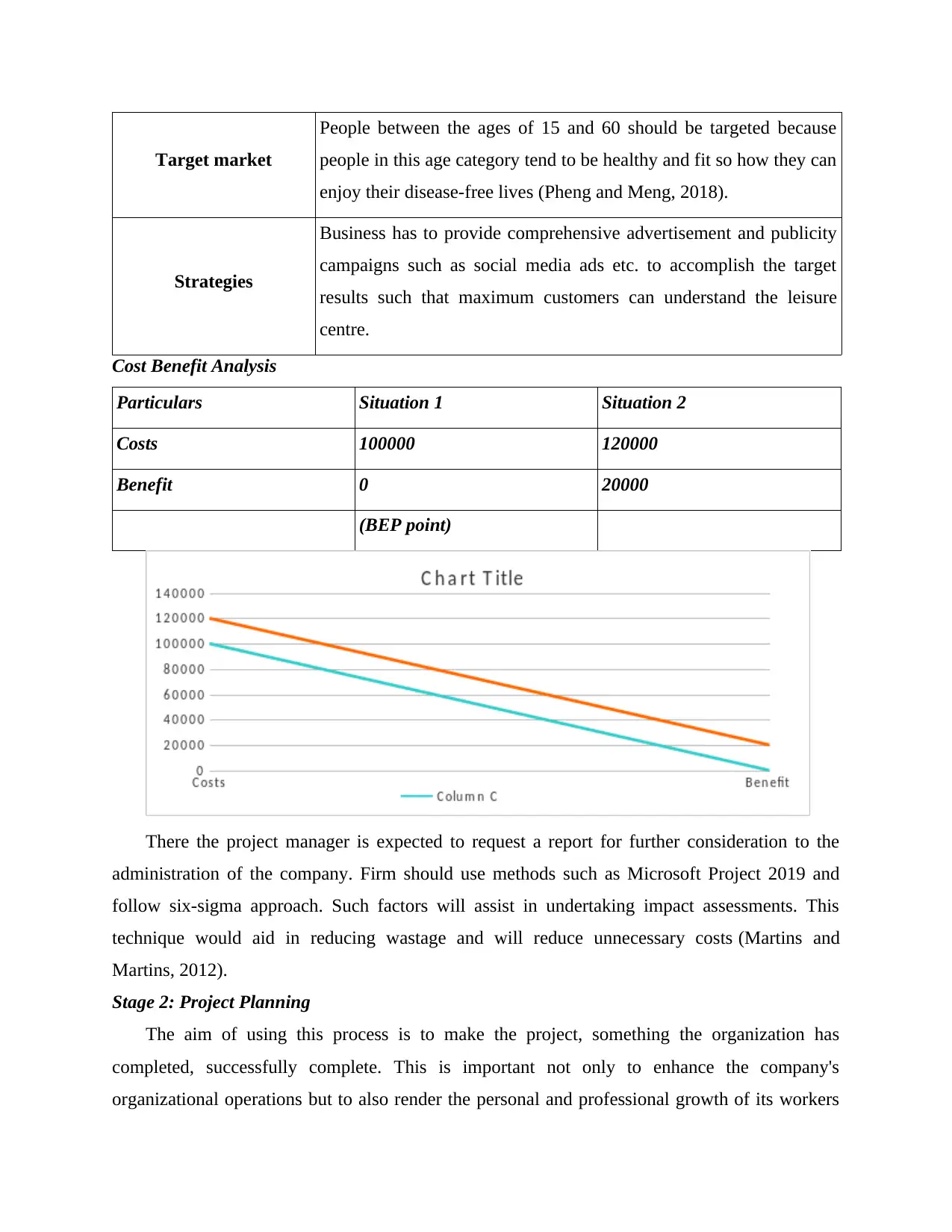
Target market
People between the ages of 15 and 60 should be targeted because
people in this age category tend to be healthy and fit so how they can
enjoy their disease-free lives (Pheng and Meng, 2018).
Strategies
Business has to provide comprehensive advertisement and publicity
campaigns such as social media ads etc. to accomplish the target
results such that maximum customers can understand the leisure
centre.
Cost Benefit Analysis
Particulars Situation 1 Situation 2
Costs 100000 120000
Benefit 0 20000
(BEP point)
There the project manager is expected to request a report for further consideration to the
administration of the company. Firm should use methods such as Microsoft Project 2019 and
follow six-sigma approach. Such factors will assist in undertaking impact assessments. This
technique would aid in reducing wastage and will reduce unnecessary costs (Martins and
Martins, 2012).
Stage 2: Project Planning
The aim of using this process is to make the project, something the organization has
completed, successfully complete. This is important not only to enhance the company's
organizational operations but to also render the personal and professional growth of its workers
People between the ages of 15 and 60 should be targeted because
people in this age category tend to be healthy and fit so how they can
enjoy their disease-free lives (Pheng and Meng, 2018).
Strategies
Business has to provide comprehensive advertisement and publicity
campaigns such as social media ads etc. to accomplish the target
results such that maximum customers can understand the leisure
centre.
Cost Benefit Analysis
Particulars Situation 1 Situation 2
Costs 100000 120000
Benefit 0 20000
(BEP point)
There the project manager is expected to request a report for further consideration to the
administration of the company. Firm should use methods such as Microsoft Project 2019 and
follow six-sigma approach. Such factors will assist in undertaking impact assessments. This
technique would aid in reducing wastage and will reduce unnecessary costs (Martins and
Martins, 2012).
Stage 2: Project Planning
The aim of using this process is to make the project, something the organization has
completed, successfully complete. This is important not only to enhance the company's
organizational operations but to also render the personal and professional growth of its workers
Paraphrase This Document
Need a fresh take? Get an instant paraphrase of this document with our AI Paraphraser
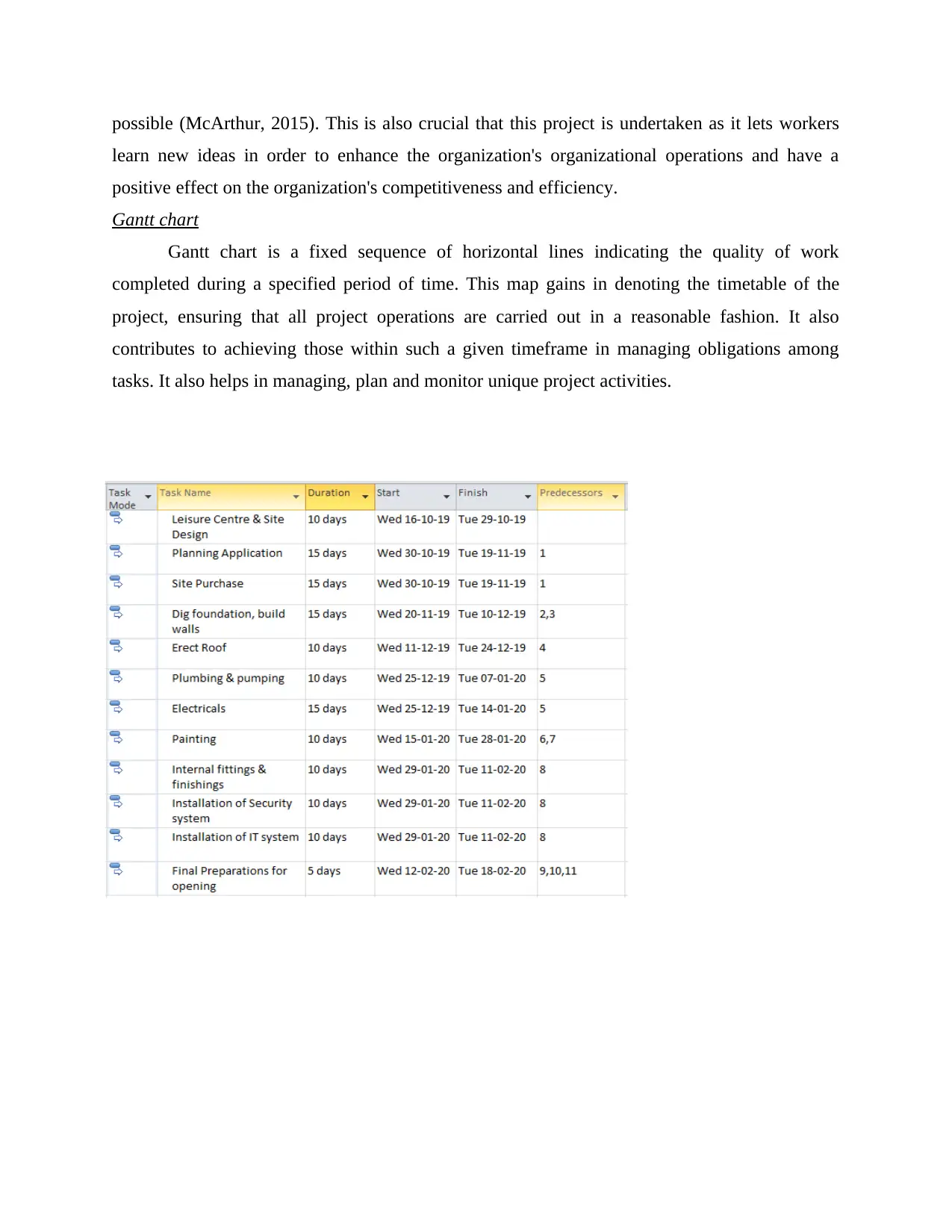
possible (McArthur, 2015). This is also crucial that this project is undertaken as it lets workers
learn new ideas in order to enhance the organization's organizational operations and have a
positive effect on the organization's competitiveness and efficiency.
Gantt chart
Gantt chart is a fixed sequence of horizontal lines indicating the quality of work
completed during a specified period of time. This map gains in denoting the timetable of the
project, ensuring that all project operations are carried out in a reasonable fashion. It also
contributes to achieving those within such a given timeframe in managing obligations among
tasks. It also helps in managing, plan and monitor unique project activities.
learn new ideas in order to enhance the organization's organizational operations and have a
positive effect on the organization's competitiveness and efficiency.
Gantt chart
Gantt chart is a fixed sequence of horizontal lines indicating the quality of work
completed during a specified period of time. This map gains in denoting the timetable of the
project, ensuring that all project operations are carried out in a reasonable fashion. It also
contributes to achieving those within such a given timeframe in managing obligations among
tasks. It also helps in managing, plan and monitor unique project activities.
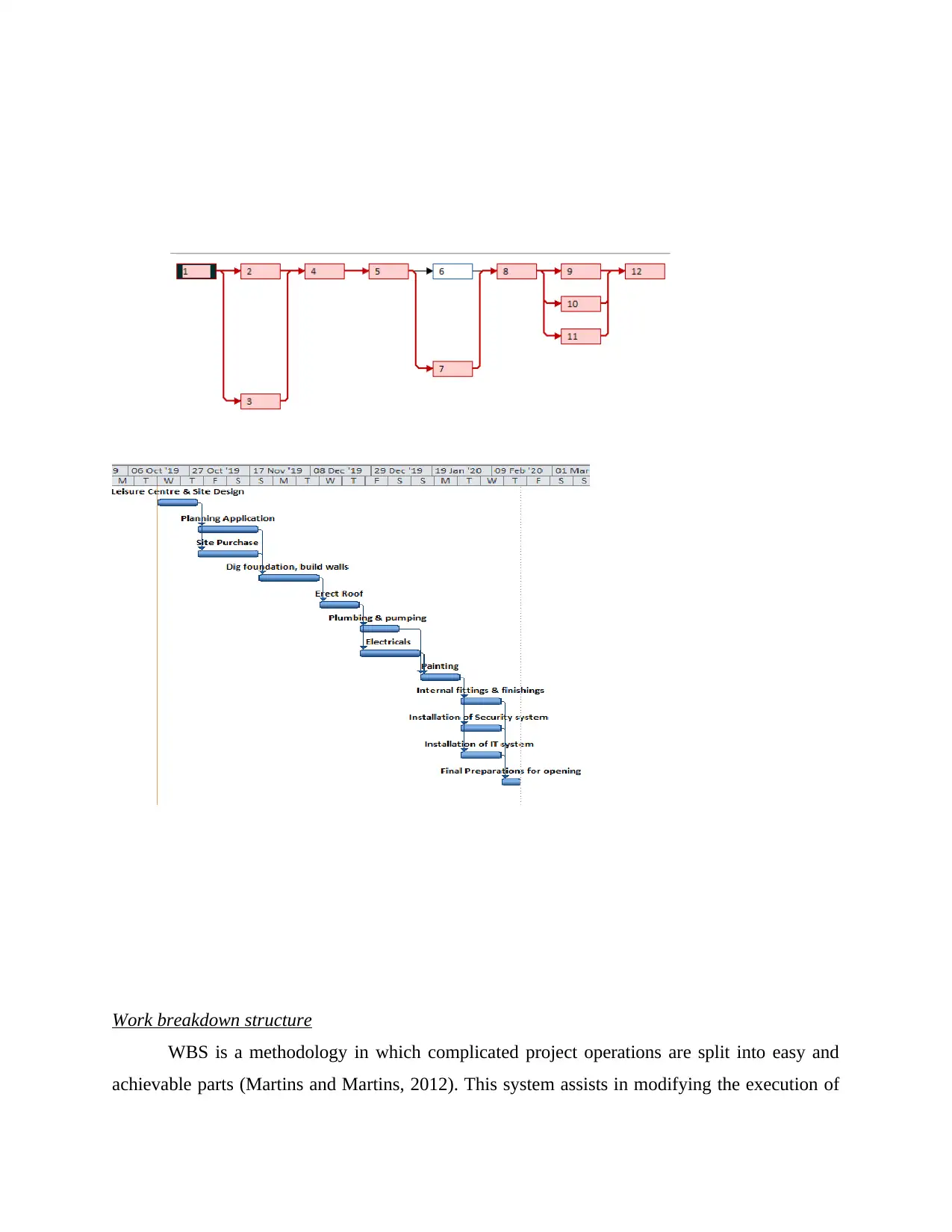
Work breakdown structure
WBS is a methodology in which complicated project operations are split into easy and
achievable parts (Martins and Martins, 2012). This system assists in modifying the execution of
WBS is a methodology in which complicated project operations are split into easy and
achievable parts (Martins and Martins, 2012). This system assists in modifying the execution of
⊘ This is a preview!⊘
Do you want full access?
Subscribe today to unlock all pages.

Trusted by 1+ million students worldwide
1 out of 21
Related Documents
Your All-in-One AI-Powered Toolkit for Academic Success.
+13062052269
info@desklib.com
Available 24*7 on WhatsApp / Email
![[object Object]](/_next/static/media/star-bottom.7253800d.svg)
Unlock your academic potential
Copyright © 2020–2025 A2Z Services. All Rights Reserved. Developed and managed by ZUCOL.





